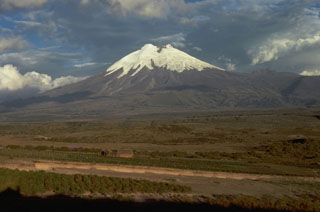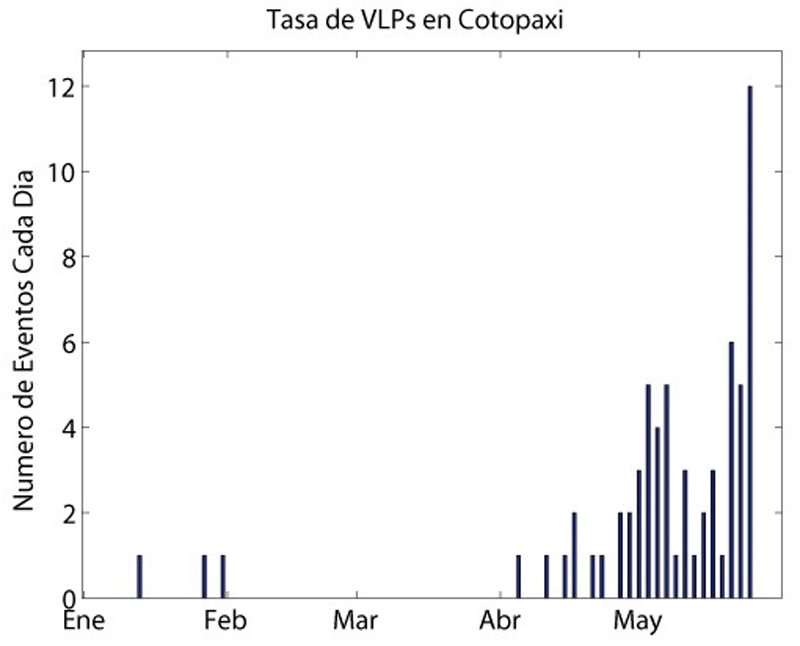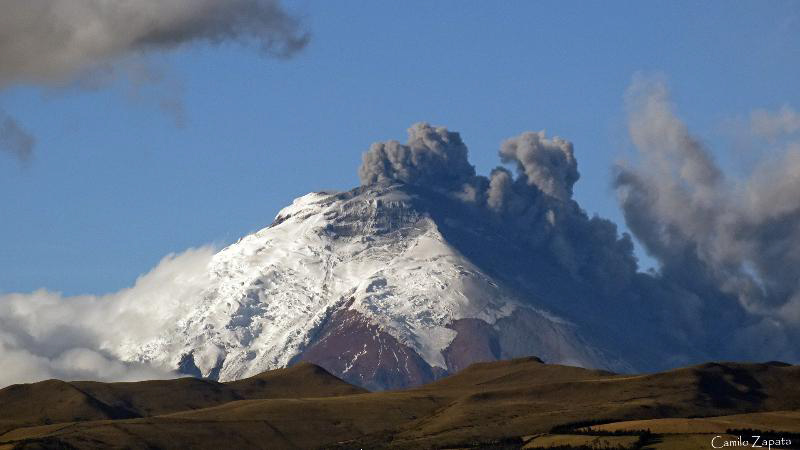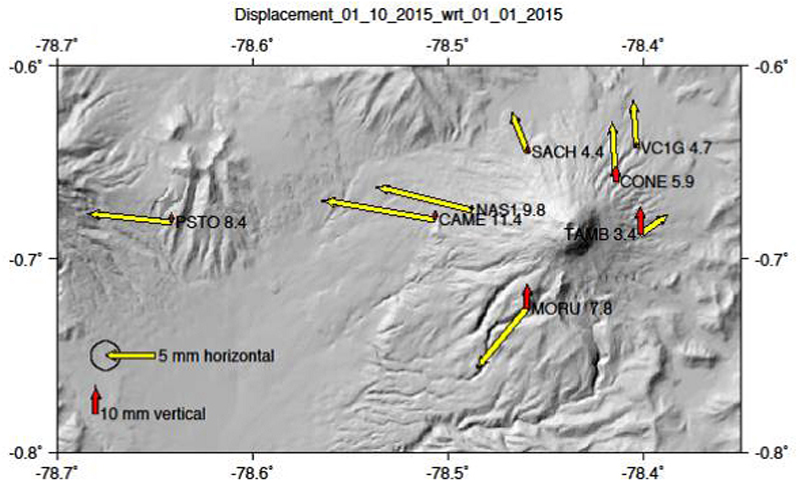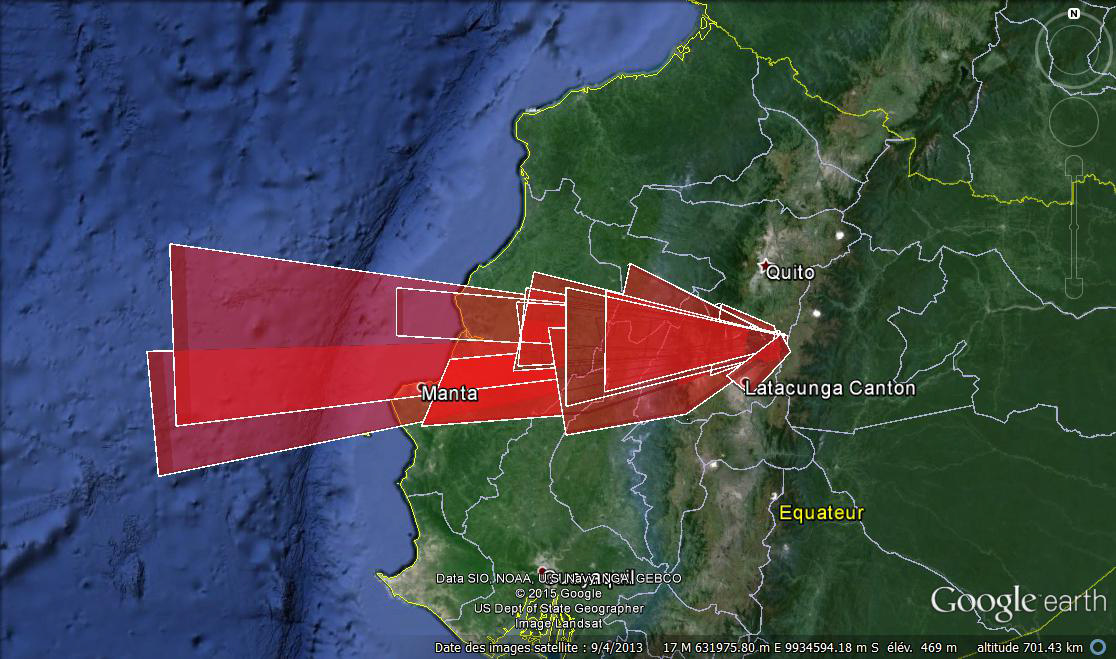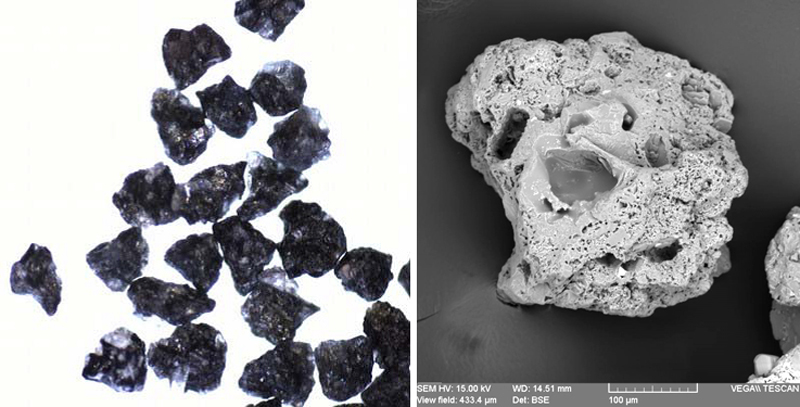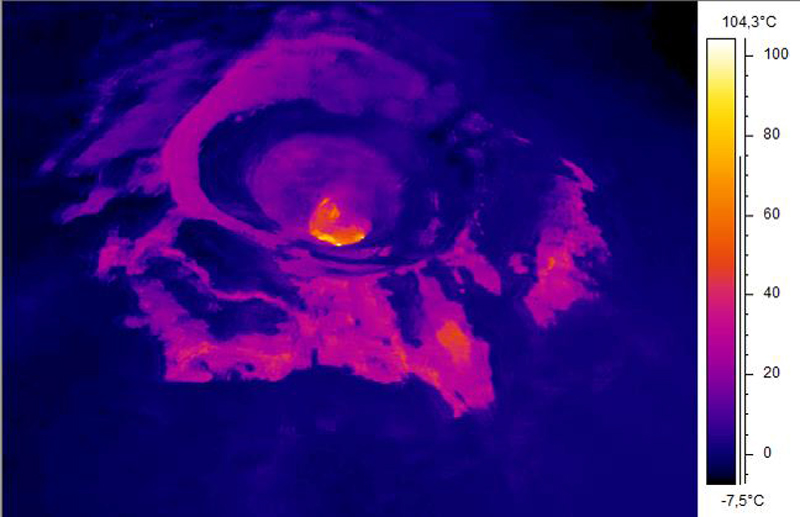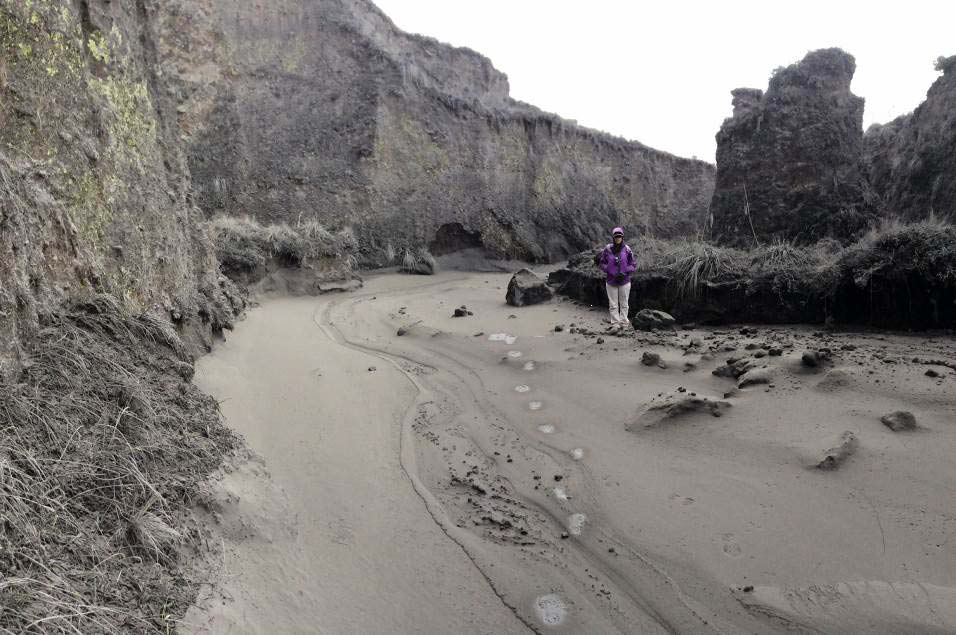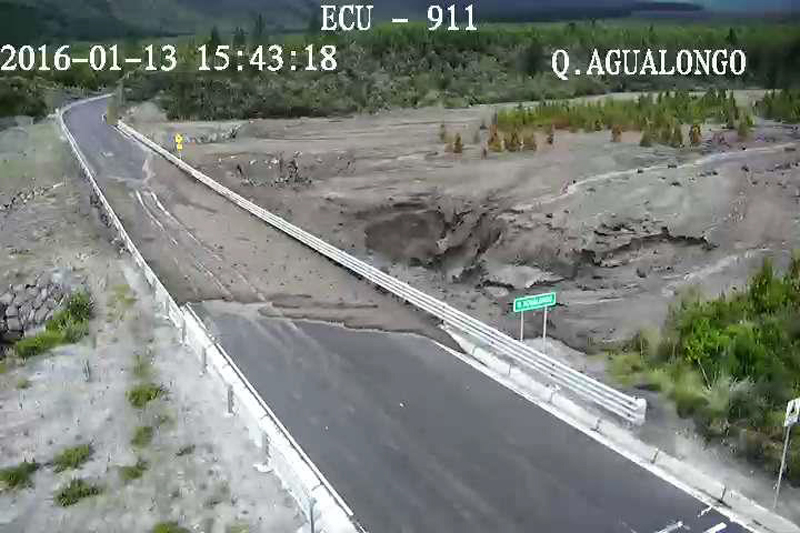Report on Cotopaxi (Ecuador) — April 2016
Bulletin of the Global Volcanism Network, vol. 41, no. 4 (April 2016)
Managing Editor: Edward Venzke.
Edited by A. Elizabeth Crafford.
Cotopaxi (Ecuador) First eruption since the 1940's begins 14 August 2015
Please cite this report as:
Global Volcanism Program, 2016. Report on Cotopaxi (Ecuador) (Crafford, A.E., and Venzke, E., eds.). Bulletin of the Global Volcanism Network, 41:4. Smithsonian Institution. https://doi.org/10.5479/si.GVP.BGVN201604-352050
Cotopaxi
Ecuador
0.677°S, 78.436°W; summit elev. 5911 m
All times are local (unless otherwise noted)
Historically, Cotopaxi has been an active, dangerous volcano, although it had been mostly quiet for the previous 70 years before beginning a new eruptive period during August-November 2015 (figure 2). Increased seismic activity, deformation, ash plumes and ashfall, SO2 emissions, fumarolic activity, and lahars were all observed by geoscientists from the Geophysical Institute of Ecuador (IG) during the 2015 eruptive phase; information in this report comes from IG unless otherwise noted.
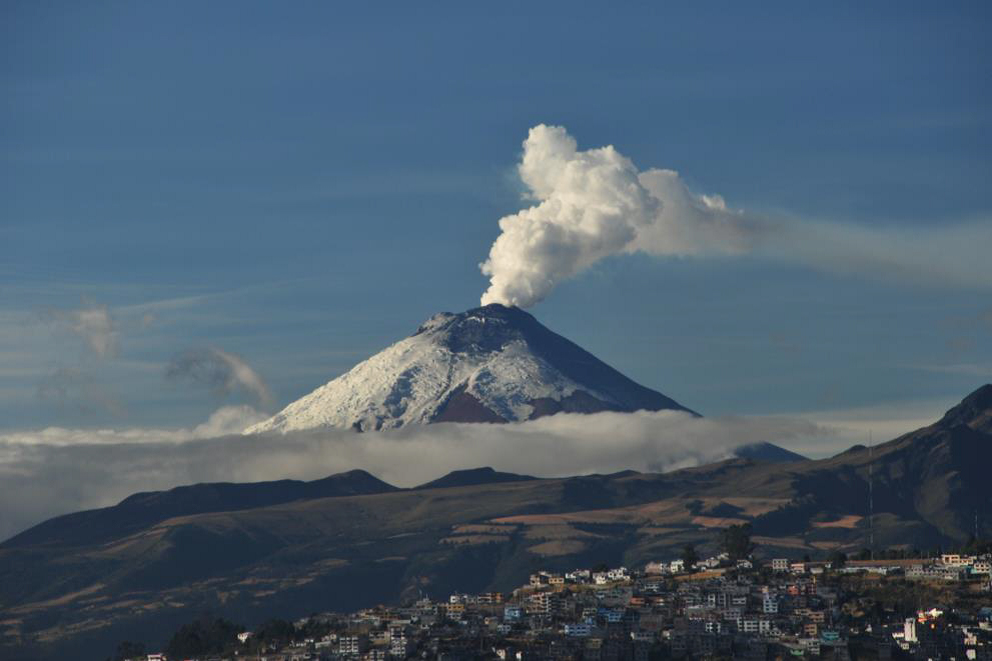 |
Figure 2. Cotopaxi volcano, 21 September 2015. View is towards the south; the plume is rising 1.5 km above the summit and drifting WSW. Photo by B. Bernard, courtesy of IG. |
The first phreatic explosions took place on 14 August 2015 and spread ash across the region up to 48 km NW, followed by a pyroclastic flow on the W flank the next morning. The first eruptive phase with numerous explosions and high seismicity continued through mid-September. A shorter explosive episode occurred in October, and the last significant ashfall was in late November. The Cotopaxi National Park was reopened to visitors in late December, as both seismic and surficial activity had declined significantly. The last ash emission was reported on 24 January 2016. The first rain-induced lahar occurred in late August, and numerous others were recorded in November 2015 and February 2016.
Pre-eruption activity. During 2002 and 2003, observations of increased seismicity included a large number of fracture-related volcano-tectonic (VT) events located between 1 and 15 km below the summit accompanied by fumarolic activity and occasional steam plumes (BGVN 28:12). In spite of this heightened activity, no ash-bearing emissions were detected. From July through early September 2005, the number of VT earthquakes within a 15-km radius of the summit again increased from background levels, but none were large enough to be felt nearby. These earthquakes had a maximum magnitude of M 4.4, and ranged from 3 to 10 km below the summit. IG scientists interpreted this increased seismic activity, characterized by long-period (LP) and hybrid (HB) earthquakes, to be related to fluid mobilization. The level and magnitude of activity was similar to that which occurred during the November 2001-January 2002 period. This increase in seismicity was also shown to correlate with elevated fumarolic activity as witnessed from a video camera installed on the NW edge of the crater. Again, no ash-bearing emissions were detected.
From late 2005 through early 2015 Cotopaxi was closely monitored for seismic, thermal, fumarolic, and lahar activities. These activities remained within normal background levels until April 2015 (figure 3). Background levels of total seismic events had been in the range of 10-25 per day since 1996. They began to increase noticeably at the end of April, and reached a monthly total of 3,000 in May. The activity was located in the N and NE parts of the cone, at two different depths, 3 and 14 km below the summit.
Sulfur dioxide (SO2) emissions also increased from background levels of ~ 500 tons/day to 2,500-3,000 tons/day in late May and early June; climbers indicated intense sulfur dioxide odor on the N part of the cone during 22-23 May. Crater fumarolic activity also increased, with plumes sometimes visible from Quito (55 km N). Low-energy, pulsating gas emissions began on 10 June, and Cotopaxi National Park staff reported an increase of water flow in streams on the NE flank, suggesting increased heat flow around the volcano.
New eruption begins on 14 August 2015. An earthquake swarm beginning in the late afternoon of 13 August 2015 was followed in the early morning of 14 August by two phreatic explosions (at 0402 and 0407). A third explosion occurred at 1027, and two additional smaller explosions were recorded later in the day at 1345 and 1429 (figure 4).
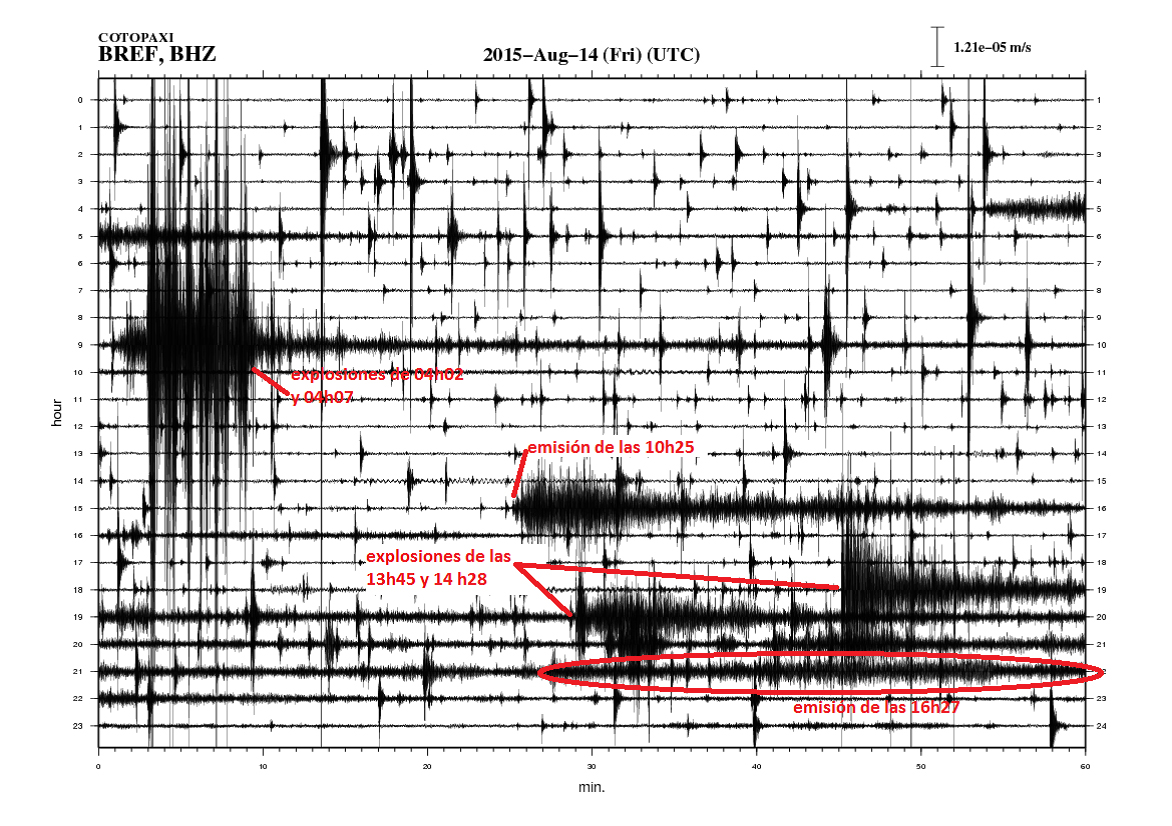 |
Figure 4. Seismograph from 14 August 2015, station BREF Courtesy of IG (Cotopaxi 2015 Special Report No. 7). |
These eruptions were witnessed by many residents in the surrounding towns and from the Metropolitan District of Quito. The Washington Volcanic Ash Advisory Center (VAAC) reported plumes from the first two explosions rising to altitudes of 12.2-13.7 km, and IG reported that the plume from the 1027 eruption rose to an altitude of 17.9 km (58,700 ft). At 0715 on 15 August a pyroclastic flow descended the W flank, sending another ash plume to at least 15.2 km, according to Washington VAAC. The lower portions of the first two plumes drifted E and the higher parts drifted SE. The plume from the third explosion drifted NW and E. Ash from the pyroclastic event drifted 17 km W, 20 km NNW, and 8 km SE as reported by Washington VAAC. According to IG special reports, ashfall was reported in areas N and NW of the volcano (figure 5) as far as 48 km away in the Machachi region, Amaguaña, Bowling, Tambillo, and S of Quito. Parts of the Cotopaxi National Park were closed to visitors. During 16-18 August, ash emissions of variable height up to 1 km continued, drifting W.
 |
Figure 5. Preliminary map of the ashfall deposits associated with the eruption of Cotopaxi on 14 August 2015. Courtesy of IG (Cotopaxi 2015 Special Report No. 9). |
The ashfall grainsize was sub-millimeter, consisting of granules, rock fragments, and mineral crystals typical of the andesitic rock of Cotopaxi. All fragments from the first eruptions appeared to be pre-existing rock, some altered, with no juvenile particles from new magma observed.
During the post-eruption overflight on 18 August, IG scientists observed variable amounts of ash and steam rising more than 100 m above the crater before descending the W flank. Significant amounts of ash were deposited on the flanks in an area from the N to the SW. New cracks on the top of some glaciers were noted, especially on the E and NE flanks, and possible new tephra deposits on the N flank were observed. Thermal images did not reveal hot material on the flank and emissions prevented measurements inside the crater. For the next week after the initial explosions, steam-and-gas emissions were occasionally observed (figure 6), with plumes rising less than 2 km above the crater.
On 22 August at 0426 the network detected an increase in the seismic amplitude, and steam-and-ash plume emissions rose to more than 3 km above the summit. More tremors at 2141 were accompanied by the onset of continuous ash emissions which rose less than 1 km above the crater, drifting SW. Rangers confirmed ashfall at the entrance of Cotopaxi National Park. The following morning IG staff found 2-mm-thick ash deposits that had accumulated during an 18-hour period. Ash deposits were also noted on 24 and 25 August in most of the N parts of Latacunga valley located about 18 km WSW of the mountain, as well as the S hills of Romerillos 15 km NW, Machachi (24 km NW), El Chaupi (24 km WNW), and Tambillo (32 km NNW).
Regular overflights were conducted by IG after the initial eruption. In September 2015 several new cracks in the glaciers were noted, and volcanic blocks had been deposited on the N and S flanks of the crater. The circular glacier at the top of the crater had significantly decreased in size and developed large fractures. Glacial melting on the upper flanks had also accelerated; streams of meltwater were present on the N flank.
By late September, the glacier inside the crater had almost disappeared. Several areas of landslide deposits inside and outside the crater were also noted. Yellowish-green deposits from increased fumarolic activity were most apparent on the S, SE, and E flanks. Rapid melting from the glacier was evident on the upper E flank which resulted in material falling onto the lower part of the glacier. Seismicity, deformation, fumaroles, ash plumes and ash fall, SO2 emissions, and lahar activity all continued for several months as discussed below, gradually tapering off toward the end of 2015.
Seismic activity. Seismic data during the August through December 2015 period correlated closely with the rise and fall of eruptive activity. The measurements of the average seismic amplitudes (RSAM) for the volcano (figure 7) reveal the dramatic increase in total seismic energy during the main eruptive phase between mid-August and early September.
Numbers of tremor signals indicating emissions (figure 8) showed a dramatic increase beginning on 14 August, and remained elevated through the initial eruptive cycle ending in early September. A second episode of emission activity in mid-October had fewer events, but the number was still higher than background levels. Seismic activity from emissions tapered off substantially after mid-October.
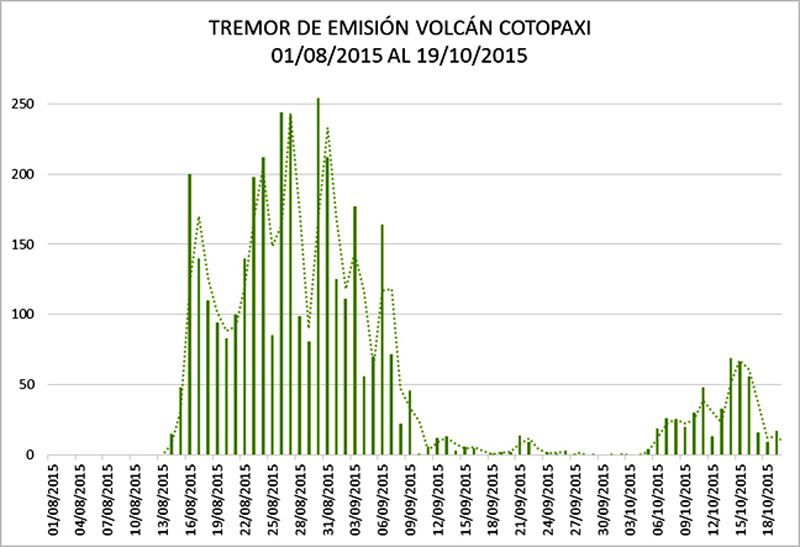 |
Figure 8. Plot of number of daily seismic tremor events indicating emissions at Cotopaxi, 1 August through 19 October 2015. Courtesy of IG (Cotopaxi 2015 Special Report No. 20). |
The number of daily volcano-tectonic (VT), or fracture-related earthquakes, located immediately beneath the crater to a depth of 12 km, increased starting in mid-August, to a maximum of over 200 events on 20 September before declining below 100 in early October. In September, the higher daily number of VT signals 3-12 km deep aligned with the conduit were interpreted by IG scientists as movement in a magma reservoir. Elevated numbers of VT events continued into February 2016, when they dropped back close to background levels (figure 9).
Deformation. As part of the activities conducted jointly by the French IRD (Institut de Recherché pour le Developpement) and IG, Jean Mathieu Nocquet analyzed the deformation data from the volcano (figure 10). The accumulated movement of the GPS points between 1 January and 1 October 2015 is shown with values corrected for drift due to tectonic movement and seasonal effects based on data from 2010-2015. The strain level was low but significant compared to other deformation events prior to eruptions. The rate of deformation began accelerating in April 2015. The maximum total movement during this time was 1 cm at sites on the W flank. The average rate of deformation observed during this period was 3 mm per month.
Ash and steam emissions. Ashfall calculations reported by IG for 14 August through 25 September were 771,000 m3 and 9.46 × 108 kg. IG scientists estimated that the volume of the initial plume material ejected on 14 August was 56,000 m3. The largest volume of tephra was erupted during 22-28 August. The area most affected that week was west of the volcano between San Juan de Pastocalle (20 km WSW) and El Chaupi (24 km WNW). Based on Washington VAAC reports, IG noted on 26 August that the plume rose as high as 9 km. As a result of this, during the last week in August, areas over 200 km to the W, WSW and SW, and up to 95 km NW reported ashfall, millimeters thick in some areas. The mayor of Sigchos, in the Province of Cotopaxi, noted impacts on livestock, crops, and greenhouses (figure 11).
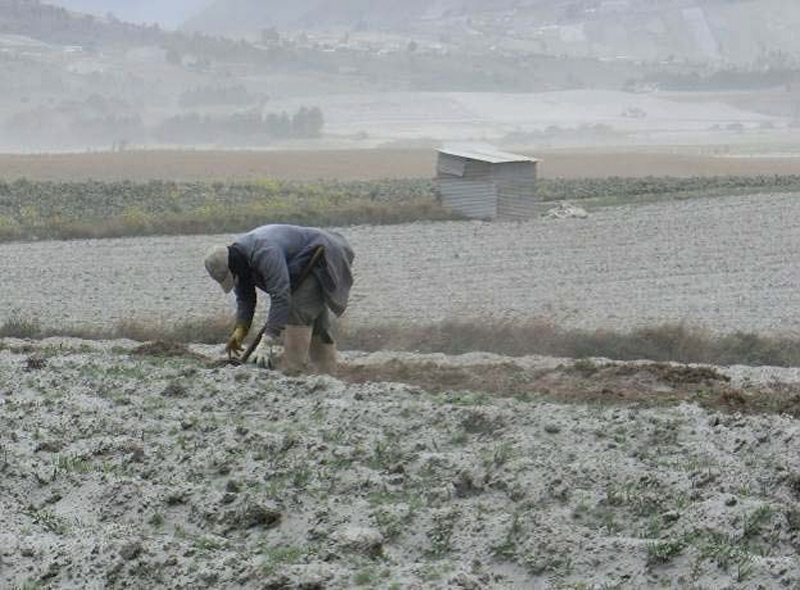 |
Figure 11. Farmland covered by a blanket of ash in Romerillos, 15 km NW of Cotopaxi, on 28 August 2015. Photo by P. Mothes. Courtesy of IG (Cotopaxi 2015 Special Report 13). |
A news article from 14 September noted that area flights had been re-routed around Cotopaxi to avoid ash plumes; the most affected route was between Quito and Guayaquil. Based on information from Washington VAAC, during 4-11 September the ash clouds associated with activity at Cotopaxi affected a large area of Ecuador (figure 12).
The height of the ash clouds during 4-11 September decreased from over 6 km above the crater the previous week to less than 3 km, along with a decrease in the intensity of seismic activity. The speed of the ash clouds during this week varied between 3.9 and 14.1 meters per second (m/s) with the prevailing wind direction towards the west (between SW and W). Clouds of ash reached the W coast, drifting as far as 465 km on 9 September. There were at least two VAAC reports issued in October, but the volumes and masses of these eruptions were not calculated.
Significant ash-and-steam emissions continued from Cotopaxi until 23 November 2015 . The plumes generally rose no more than 2 or 2.5 km above the crater and usually drifted N or NW, and occasionally W or SW. Intermittent ashfall was reported from numerous towns through 18 November, generally from areas W and N of the volcano at distances up to 60 km. A summary of towns that reported ash and their distance and direction from Cotopaxi is shown in Table 4. The last significant ashfall reported by IG was on 23 November 2015. By December, the height of the steam plumes had decreased to consistently 1 km or less above the crater. No ashfall was reported in December inside the park or surrounding area, but traces of ash were observed covering parts of the glacier on the flanks of the volcano. At 1843 on 24 January a plume with low-to-moderate levels of ash rose 700 m above the crater and drifted W. The emission coincided with a hybrid earthquake. This was the last reported ash through March 2016.
Ash characteristics. Analysis of ash collected on 2 September showed that the greatest contribution of material was from pre-existing and altered rock. A week later, analysis of ash samples showed an increase in the proportion of juvenile fragments. A grain size analysis of ash samples indicated a very high proportion of extremely fine ash (30 to 75% less than 63 microns). Other than the ash recovered on the first day of the eruption (14 August ) which had a slightly larger size distribution, subsequent samples were consistently very fine to extremely fine in size. Component analysis performed with binocular and scanning electron microscopes clearly showed an evolution of the ash toward a decreased contribution of preexisting rock (lithic fragments with pyrite, grey scoria with vesicles filled with hydrothermal material, hydrothermal quartz) and an increased proportion of fresh magmatic material (free crystals, glass particles with few vesicles and a high percentage of microlites), especially after 28 August (figure 13).
SO2 emissions. SO2 emissions at Cotopaxi began to rise above typical background levels of ~ 500 t/day in late April 2015, and were consistently above 2,500 t/d by late May (figure 14). Values measured by IG scientists peaked on 15 August, the day after the initial explosion, at 16,700 t/d, and declined to 5,490 by 20 August. Emissions on 14 August were also detected by the Ozone Monitoring Instrument (OMI) (figure 15). A total of 350,000 tons of SO2 emissions was recorded in August 2015. Values spiked between 5,000 and 10,000 t/d numerous times between 14 August and late November 2015 before slowly decreasing to levels below 1000 t/d by January 2016, somewhat above background averages.
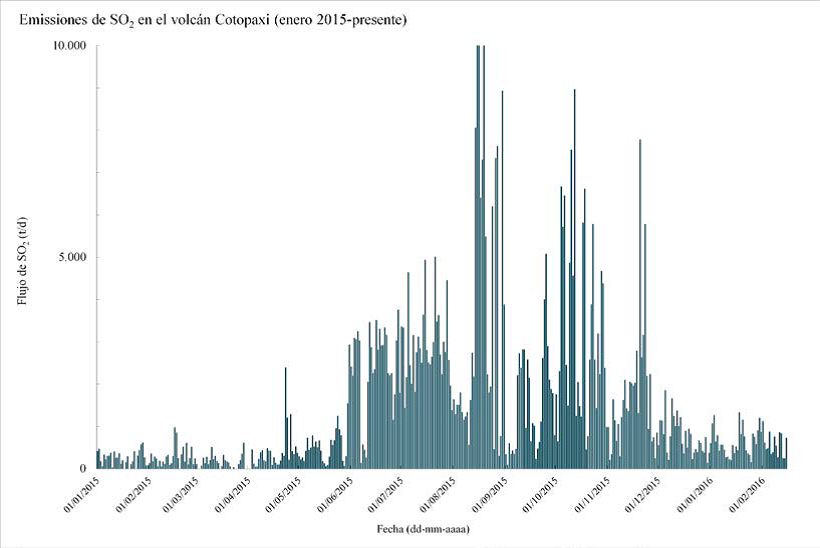 |
Figure 14. Plot of SO2 emissions (tons/day) at Cotopaxi from 1 January 2015 through 15 February 2016. Courtesy of IG (Cotopaxi 2016 Special Report 4, graph created by D. Sierra, IGEPN). |
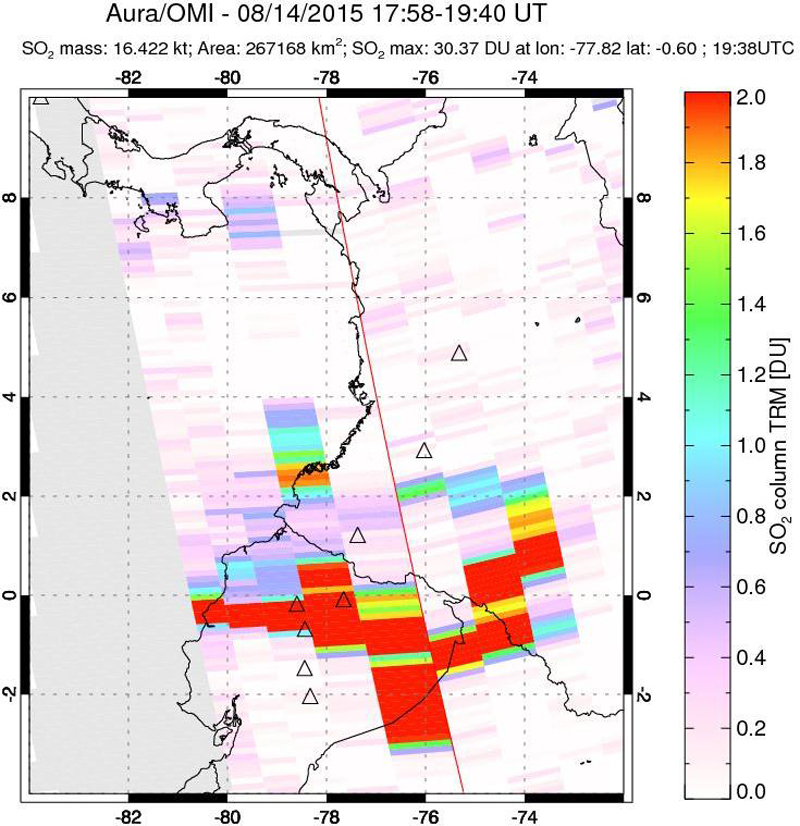 |
Area where SO2 gas emissions from Cotopaxi were detected by the OMI instrument on 14 August 2015. Red indicates higher concentrations. Courtesy NASA Goddard Space Flight Center (GSFC). |
Thermal Monitoring. The first thermal images obtained after the explosions in August occurred during overflights on 18 and 26 August, and revealed a significant increase in the temperatures of emissions. The Maximum Apparent Temperature (MAT) was 150° C on 26 August at several different areas within the crater. By 3 September, thermal images revealed temperature increases in the S and E parts of the crater to 200° C. Bright areas at the summit were observed at night, possibly from hot block deposits. During the 9 September overflight infrared measurements indicated that temperatures had begun to decrease. This decrease continued until 29 September when new thermal anomalies on the upper parts of the outer crater were identified, likely from newly deposited material.
On a clear 2 October, IG geoscientists were able to measure and photograph the thermal anomalies identified and analyzed in previous flights (figure 16). The Maximum Apparent Temperature for the entire inner crater was 104.3° C. The MAT measured on the E flank of the volcano was 57.9° C, up from 51° C measured in the previous flight on 29 September. By 26 January, the thermal image data revealed a significant decline of the MAT to 51.9° C at the bottom of the inner crater.
Lahars. The first lahar generated by the eruptions descended the W flank of Cotopaxi on 28 August, detected as a high-frequency seismic signal from two stations on the W flank (figure 17). It was a small flow remobilized by a light rain. IG technicians located the flow and determined that the flow rate did not exceed 10 m3/s, and that it remained near the top of the volcano.
There were 58 total rainfall-induced lahars detected through March 2016, with the largest numbers occurring in November and February. They primarily descended the NW and W flanks of the volcano. Four small lahars from the melting glacier were reported in December. The largest lahar occurred at 1336 on 13 January in the Agualongo gorge (approximately 15 km. SW of the summit); a seismic station on Cotopaxi's W flank recorded an hour-long signal caused by the lahar. Preliminary results indicated that the peak flow rate was around 40 m3/s with a volume of about 50,000 m3. The lahar left deposits on the bridge that crosses the river (figure 18).
Post-eruption activity. In late December, after 119 days of closure due to volcanic activity, the Cotopaxi National Park reopened to visitors, as both seismic and surficial activity had declined significantly. By 29 January IG reported that surficial activity was characterized by minor steam emissions from the crater and sporadic gas emissions with minor amounts of ash (the last ash emission was reported on 24 January). Sulfur dioxide (SO2) emissions were less than 1,000 tons per day (near pre-eruptive levels) by the end of January and seismicity had almost returned to baseline levels. Observations in late January 2016 indicated that the glaciers were continuing to move downslope with fractures and cracking, and continued glacial melting was observed as well.
Cotopaxi remained quiet through March 2016 with minor gas emissions rising 600 m above the crater and drifting N and NW. The glacier remained cracked, and glacial melting had decreased considerably.
Table 4. Towns and villages reporting ashfall from Cotopaxi, August-November 2014.
| Town | Distance (km) | Direction |
| Aloag | 28 km | NNW |
| Aloasí | 23 km | NW |
| Bahia de Caraquez | 220 km | WNW |
| Cerro Azul | 47 km | WNW |
| Charapotó | 230 km | W |
| El Chasqui | 48 km | NNW |
| El Chaupi | 24 km | WNW |
| Jambelí | 50 km | NNW |
| Lasso | 60 km | N |
| Latacunga Valley, N part | 18 km | WSW |
| Leonidas Plaza | 40 km | N |
| Los Tsáchilas | 95 km | NW |
| Machachi | 24 km | NW |
| Manabi (El Carmen) | 165 km | W |
| Mariscal Sucre | 50 km | NNW |
| Pastocalle | 20 km | WSW |
| Pichincha | 58 km | N |
| Quito, south | 45 km | N |
| Rocafuerte | 225 km | WSW |
| Romerillos, S hills | 15 km | NW |
| Rumiñahui | 61 km | N |
| Rumipamba de Espinosas | 53 km | NNW |
| San Agustín | 35 km | SW |
| San Fernando | 58 km | NNW |
| San Isidro | 58 km | N |
| San Ramón | 127 km | W |
| Santa Catalina | 52 km | N |
| Selva Alegre | 54 km | NNW |
| Sigchos | 51 km | W |
| Tambillo | 32 km | NNW |
| Tanicuchí | 25 km | SW |
Geological Summary. The symmetrical, glacier-covered, Cotopaxi stratovolcano is Ecuador's most well-known volcano and one of its most active. The steep-sided cone is capped by nested summit craters, the largest of which is about 550 x 800 m in diameter. Deep valleys scoured by lahars radiate from the summit of the andesitic volcano, and large andesitic lava flows extend to its base. The modern edifice has been constructed since a major collapse sometime prior to about 5,000 years ago. Pyroclastic flows (often confused in historical accounts with lava flows) have accompanied many explosive eruptions, and lahars have frequently devastated adjacent valleys. Strong eruptions took place in 1744, 1768, and 1877. Pyroclastic flows descended all sides of the volcano in 1877, and lahars traveled more than 100 km into the Pacific Ocean and western Amazon basin. Smaller eruptions have been frequent since that time.
Information Contacts: Instituto Geofísico, Escuela Politécnica Nacional, Casilla 17-01-2759, Quito, Ecuador (URL: http://www.igepn.edu.ec/); Washington Volcanic Ash Advisory Center (VAAC), Satellite Analysis Branch (SAB), NOAA/NESDIS E/SP23, NOAA Science Center Room 401, 5200 Auth Rd, Camp Springs, MD 20746, USA (URL: http://www.ospo.noaa.gov/Products/atmosphere/vaac/); OMI (Ozone Monitoring Instrument), Global Sulfur Dioxide Monitoring, Atmospheric Chemistry & Dynamics, NASA Goddard Space Flight Center, Goddard, Maryland, USA (URL: https://so2.gsfc.nasa.gov/); El Comercio (URL: http://www.elcomercio.com/actualidad/aerovia-actividad-cotopaxi-ecuador-negocios.html).

